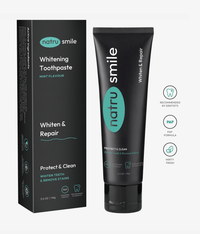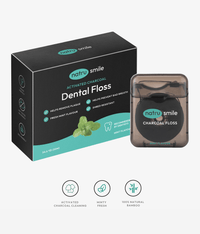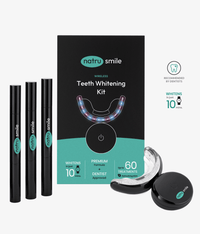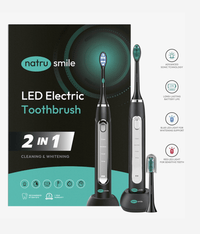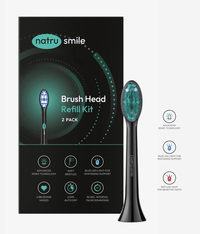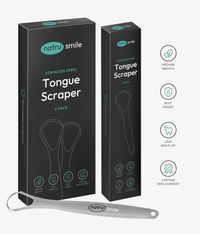
All products are certified by dental expert Dr. Greg Grillo
Did you get a dental filling recently and now have some lingering tooth pain? It's not uncommon – in fact, it's pretty normal. But that doesn't mean it isn't annoying or even downright excruciating! Before you panic, know that there are reasons why this can happen and ways to help reduce the discomfort. Let's take a look at what might be causing your post-filling tooth pain, as well as how to get relief.
Is It Normal To Have Pain After A Filling: Overview
More than 90% of adults who are 20 years old or older have had at least one cavity. That means that, statistically speaking, fillings are pretty common.
And while the filling process itself can sometimes be uncomfortable, it's usually done with numbing agents and other pain relief measures so that the patient isn't in any real discomfort during the procedure.
But what about after? Is it normal to have tooth pain after a filling? The short answer is yes – while this doesn't always happen, some degree of post-filling soreness and discomfort is not uncommon. This can last anywhere from a few days to a few weeks, depending on the person and the procedure itself.
However, if the pain persists for more than a few days or gets progressively worse, you should seek medical attention – especially if it's accompanied by other symptoms like fever, difficulty breathing, swelling of the jaw/cheeks, or severe headaches.
Reasons For Pain After A Filling
Whether you get temporary fillings or permanent fillings, it’s possible to feel pain after your appointment. So, why does this happen? There are a few potential culprits – here are some of the most common:
An Irritated Nerve
Sometimes, the numbing agents used during the filling procedure don't completely prevent nerve irritation. This can happen if there was a lot of drilling or if it was particularly deep. In this case, you're likely to feel some pain and discomfort after the fact as your nerve slowly recovers from being disturbed.
Incorrect Bite Alignment
Fillings can cause misalignment of the bite, which is how your upper and lower teeth fit together when you close your mouth. If this happens, it can put extra pressure on specific teeth, which can cause pain after the fact. This situation might require heading back to the dentist and asking them to shave down the filling, or it may correct itself over time.
Untreated Tooth Infection
All in all, tooth infection will usually be accompanied by other symptoms such as pain when chewing and sensitivity to hot or cold food and drinks, making it easy to catch early on.
If the tooth being filled was infected, there's a chance that some of the infection could remain after the procedure. You might experience pain, sensitivity, and other unpleasant symptoms as a result, and the pain could last longer than average. Your dentist will need to remove the filling and treat the infection before replacing it.
Tooth Crowding Issue
If you've recently had a filling placed in a crowded area, it could be causing some localized pain. This is because – when there isn't enough room for the tooth and its filling – pressure can build up, leading to soreness and discomfort.
Tooth crowding can often be the cause of cavities in the first place because the tooth can become weakened and more susceptible to decay. To ensure this doesn’t become a cycle, it’s recommended to take care of the issue with braces or other orthodontic treatments.
Gingivitis Or Periodontal Disease
If you have gingivitis or periodontal disease, your natural tooth-toughened tissues (gums) may not be able to handle the added stress of a filling. These issues can cause pain and sensitivity long after the procedure is complete. If left untreated, gingivitis can even lead to more serious dental issues down the line.
In cases where you've developed these issues after the cavity has been filled, the pain may be caused by the accumulation of plaque and tartar on the tooth. The build-up can cause pressure on nearby nerves, which results in pain. Forging ahead with a filling when this happens can make the situation worse.
Sensitive Teeth
If you have particularly sensitive teeth, your dentist might opt to use a different type of numbing agent during the filling. Because you won’t feel anything until the agent wears off, it could cause more pain after the procedure, though it should also reduce the likelihood of any lasting damage.
As well, since your teeth are naturally sensitive, you should expect more post-filling discomfort than those with non-sensitive teeth. To reduce these symptoms, your dentist might recommend a desensitizing toothpaste or sealant to help soothe the area and make it less sensitive over time.
Poor Dental Hygiene
If your dental hygiene habits aren't up to par, you could develop an infection around the filling. Infections are oftentimes caused by bacteria and food particles being trapped between the tooth and filling. Over time, you might feel pain in the area as well as other unpleasant symptoms like bad breath or a foul taste.
Changing your oral health habits post-filling is crucial to avoiding infections and avoiding future cavities. Make sure you brush twice a day, floss at least once a day, and rinse your mouth with an antiseptic mouthwash.
Eating A Sugary Diet
If you eat a lot of sugary food and drinks, the bacteria in your mouth can cause tooth decay. This is especially true when combined with poor dental hygiene. If that’s the case, it's likely that the decay has progressed to the point where it needs to be filled. But without properly cleaning and caring for the area, you may experience pain after getting a filling as the nerve recovers from being disturbed.
Other Reasons Your Tooth Hurts After A Filling
In addition to the above, there are a few other more complex reasons why your tooth might be hurting after your procedure.
Excess Filling Material
If too much filling material was used during the procedure, it can lead to pain due to pressure on the nerve. This usually resolves itself over time, but your dentist may need to remove some of the excess material if it doesn't go away after a few days.
Pulpitis
Pulpitis is when the nerve of your tooth becomes inflamed or irritated. It can be caused by bacteria entering the exposed pulp after getting a filling, and it usually requires a root canal to treat.
Sensitivity To Amalgam
The silver amalgam used in some types of fillings can cause sensitivity, especially if it's not fully cured after the procedure. If it isn’t resolved after the curing process, your dentist may need to apply a special sealant or desensitizing agent to reduce the discomfort.
Common Pain Explanations Around Fillings
If there's a specific type of pain you're feeling, you might want to figure out what it is. Here are some of the most common explanations of tooth pain after a filling:
Pain When You Bite Or Touch
If the pain is happening when you bite down or touch the area around your filling, it could be due to a high spot on the filling. This is when there's an unevenness in the surface of your tooth that can irritate your tongue or gums. Your dentist can easily fix this issue by doing some reshaping and smoothing.
Pain To Hot Or Cold
For teeth that are sensitive to temperature changes, it could be due to a crack in the tooth or an overhanging filling. To repair the tooth, you can get the filling replaced or adjusted and get any cracks sealed with dental cement.
Toothache Pain
If you're feeling an ache or throbbing tooth pain after your filling, it could be due to a number of issues. Perhaps it’s caused by bacteria that have entered the exposed pulp after getting a filling or by damage to the nerve from the filling procedure itself.
Referred Pain
Referred pain is when you feel pain in a different part of your body than where the actual problem lies. For example, if you have a filling in your lower left molar and are feeling pain in your jaw or neck, it could be due to referred pain from that tooth.
Treating Tooth Pain After A Filling
To relieve tooth pain after your filling, there are some things you can do to help ease the pain.
Use Toothpaste For Sensitive Teeth
If your tooth is sensitive, try using a toothpaste made for sensitive teeth to help reduce the discomfort and protect your teeth from further damage. These products often include potassium nitrate, which works to soothe the nerves in your teeth. Another common ingredient, stannous fluoride, protects your dentin in order for the shocking pain from reaching your nerves.
Take Pain Medications
Severe toothaches and pain might require over-the-counter medication. Especially if a toothache after filling is getting worse, acetaminophen (Tylenol) or ibuprofen (Advil) can help reduce the discomfort. Be sure to follow the instructions on the packaging and never exceed the recommended dosage.
Use Cold Compresses
Applying a cold compress, such as an ice pack wrapped in a towel, may help reduce the pain and inflammation caused by your filling. Place the cold compress on the affected area for 15 minutes at a time to get relief. Be sure not to leave it on too long or you could cause more damage than good.
Try An Analgesic Ointment
If your toothache seems to be radiating from the inside of your mouth, you may want to try using an analgesic ointment. These are available over-the-counter and work by numbing the area around your tooth, as well as providing some anti-inflammatory relief.
Use A Softer Toothbrush
Using a softer toothbrush can help reduce the pain you're feeling after your filling. Harder bristles can irritate the area around your filling and cause more discomfort, so be sure to switch to one with soft or extra-soft bristles. In general, the American Dental Association (ADA) recommends soft bristles to minimize the risk of gum abrasion.
Stay Away From Teeth Whitening Products
If you're experiencing tooth pain after a filling, it's best to stay away from whitening products as they can cause further irritation. Whitening products have a high concentration of hydrogen peroxide, which can be too harsh for recently filled teeth.
In-office whitening treatments are even harsher and should be avoided until your mouth has had time to heal. Instead, try using a mild fluoride rinse or toothpaste that specifically targets sensitivity.
Say No To Hot And Cold Foods
Steer clear of hot and cold foods at least 24 hours after the procedure. While the filling itself may be heat-resistant, the surrounding tooth enamel is not. Eating or drinking something that is too hot can cause further discomfort. The same goes for cold temperatures – they can cause sensitivity in filled teeth as well.
Some suitable foods you can eat in the hours after your filling include:
- Soft foods such as yogurt, mashed potatoes, and applesauce
- Room temperature liquids such as water
- Cooked vegetables like carrots or peas
- Protein sources like boiled eggs or cooked fish
Complications From Fillings
In some cases, tooth pain after a filling can be the result of complications from the procedure.
Leakage From Filling
Fillings can develop a small leak or fracture, especially amalgam fillings (made of metal), as they are more susceptible to fracture over time. If you suspect your filling might be leaking, have it checked out by a dental professional right away.
Anesthetic Issues
The anesthetic used during a filling can cause some lingering issues. If you're still feeling numb after your appointment, it could be due to the anesthetic and will usually wear off within a few hours.
Development Of A Cavity
It's also possible that the filling wasn't placed properly, and a small cavity has formed underneath it. This is especially common with composite fillings (made of plastic). If this happens, you may experience tooth pain after your filling. Your dentist will be able to check for any cavities using x-rays and then fix the problem if necessary.
Uneven Bite
Another potential cause of tooth pain after a filling is an uneven bite. During the procedure, the filling may have been placed too high or low and is causing you to put more pressure on one side than the other when you chew. Your bite can be adjusted so that it's even and not putting any extra strain on your teeth.
Large Cavities
Larger cavities can be more prone to pain after a filling. If the cavity was particularly deep or extensive, it may take some time for your tooth to get used to the new material and adjust accordingly.
Damage To Other Teeth
Some fillings can cause damage to other teeth in your mouth as well. If the dentist drilled too deeply into an adjacent tooth, it can cause pain and irritation.
The filling will need to be repaired or replaced to ensure that all of your teeth are healthy and functioning properly.
Do you have more important questions that you need answered about tooth pain related to a filling? Read on.
Do Fillings Hurt After A Few Months?
It is not uncommon for tooth pain to occur after a filling as your teeth are naturally adjusting and settling into their new shape after the procedure.
Sometimes it can take time for the nerves of your teeth to settle down and get used to the changes caused by a filling. If this pain persists after a week or two, it could be a sign of other complications.
Is It Normal For The Jaw To Hurt After A Filling?
Your jaw may hurt after a filling as the procedure causes some trauma to the area. This pain should dissipate shortly after the appointment and can be managed with over-the-counter medication. If it lasts for an extended period of time, you should have your dentist check for other potential causes, such as an infection or inflammation.
How Long Should A Tooth Hurt After A Filling?
It is normal to experience some tooth pain after a filling, and it should only last for a few days. If the pain lingers beyond that, or you have extreme tooth pain after the filling, you should contact your dentist right away.
Why Does My Filling Hurt After Years?
If your filling is causing pain after years, this could be a sign of decay or cracking in the tooth. Over time, the filling may have worn down and left open spaces where bacteria can accumulate and cause damage. Keep in mind that although fillings are made to last, they won’t last forever. After several years, you’ll need to get the filling replaced or potentially a crown.
When Should I Worry About A Toothache After A Filling?
If you feel pain that persists for more than a few days after your filling, then it's time to visit your dentist. Pain can often be a sign of infection or other issues that need to be addressed in order to prevent further damage or discomfort.
What Happens If A Filling Is Too Close To The Nerve?
Deep fillings have a possibility of being too close to the nerve and causing serious pain. If this occurs, it may just be that the nerve is irritated after the procedure, and it will heal itself over time. If the pain isn’t going away, a dental professional may need to remove the filling or perform root canal therapy in order to reduce the pain.
How Long Does A Filling Take To Heal?
The healing process after a filling can take anywhere from several days to weeks, depending on the size and depth of your filling. Usually, you should feel back to normal within a week or two.
Why Does My Gum Still Hurt After A Filling?
Gum pain after a filling is normally caused by an infection or irritation in the area. It’s natural for there to be some inflammation as your body adjusts to the new filling, but if it persists for more than a few days, then you should book another dental appointment.


